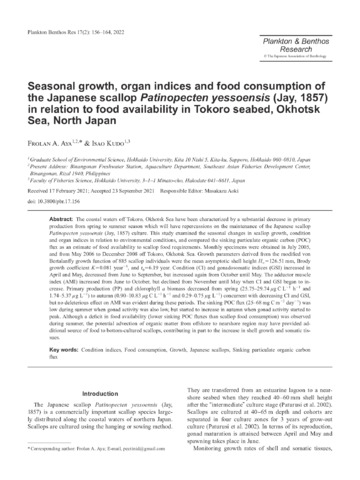Dissolved Carbonate-carbon Dioxide in Sea Water of the South China Sea, Area II: Sabah, Sarawak and Brunei Darussalam
Share
Abstract
Dissolved carbonate species in seawater are determined from pH and total alkalinity. The data clearly pointed out the significance of Rajang River as a source of organic matters that were subsequently decomposed and cause CO2 gas to evade from nearshore water in its vicinity into the atmosphere while most offshore surface water was the sink of atmospheric CO2. The total alkalinity profiles indicated dissolution of carbonate minerals, believed to be high magnesian calcite, below 500 m, which reinforce CO2 storing capacity of these waters.
Suggested Citation
Snidvongs, A. (1999). Dissolved carbonate-carbon dioxide in sea water of the South China Sea, Area II: Sabah, Sarawak and Brunei Darussalam. In Proceedings of the Second Technical Seminar on Marine Fishery Resources Survey in the South China Sea, Area II: West Coast of Sabah, Sarawak and Brunei Darussalam, 14-15 December 1998, Kuala Lumpur, Malaysia (pp. 62-94). Samut Prakan, Thailand: Training Department, Southeast Asian Fisheries Development Center.
Subject
Related items
Showing items related by title, author, creator and subject.
-
Diet-tissue stable isotopic fractionation of tropical sea cucumber, Holothuria scabra
Watanabe, Satoshi; Kodama, Masashi; Sumbing, Joemel Gentelizo; Lebata-Ramos, Maria Junemie Hazel (Japan International Research Center for Agricultural Sciences (JIRCAS), 2013)To provide a basis for a stable carbon and nitrogen isotope ratio \(\mathsf{(\delta^{13}C / \delta^{15}N)}\) analysis to determine the assimilated organic matter in sea cucumber, Holothuria scabra, diet-tissue fractionations ... -
Dissolved Oxygen and Carbonate-carbon Dioxide in the Sea Water of the South China Sea, Area I: Gulf of Thailand and East Coast of Peninsular Malaysia
Rojana-anawat, Penjan; Snidvongs, Anond (Training Department, Southeast Asian Fisheries Development Center, 1999)Dissolved oxygen and carbonate system in seawater in the Gulf of Thailand and the east coast of Peninsular Malaysian September 1995 and April-May 1996 were determined. It was found that surface water was well in equilibrium ... -
Seasonal growth, organ indices and food consumption of the Japanese scallop Patinopecten yessoensis (Jay, 1857) in relation to food availability in Tokoro seabed, Okhotsk Sea, North Japan
Aya, Frolan; Kudo, Isao (The Plankton Society of Japan (The Japanese Association of Benthology), 2022-05-30)The coastal waters off Tokoro, Okhotsk Sea have been characterized by a substantial decrease in primary production from spring to summer season which will have repercussions on the maintenance of the Japanese scallop ...





